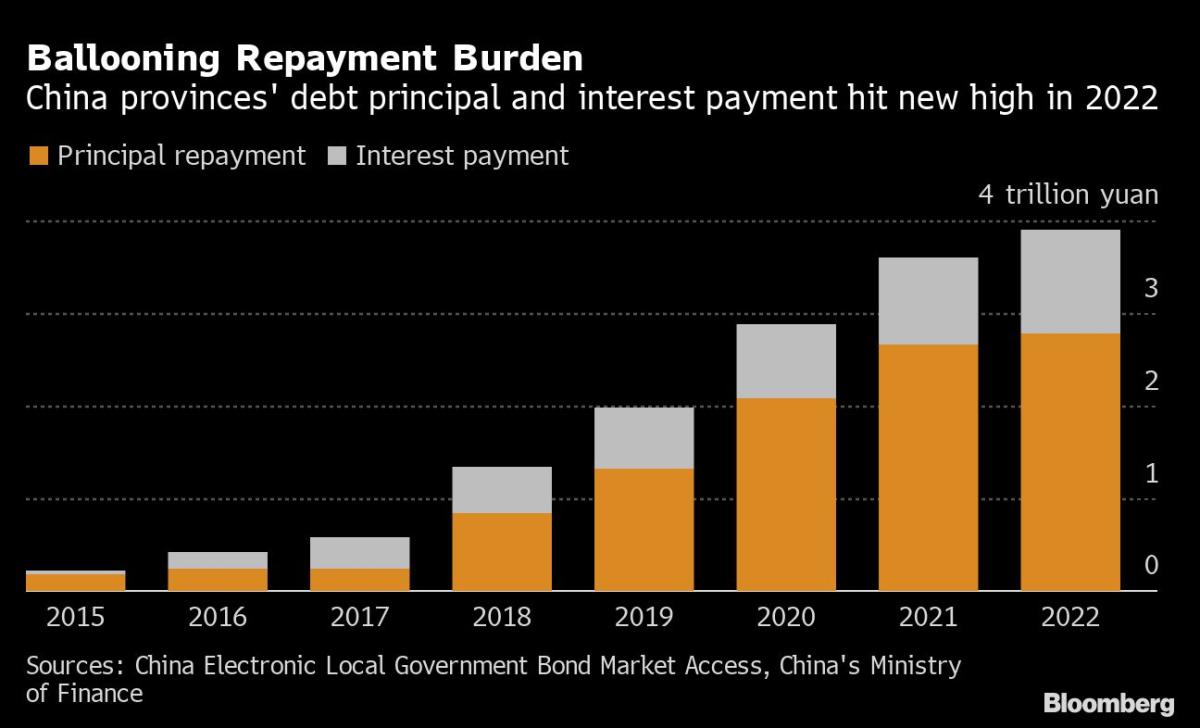China Debt Blowout Rings Alarm Bells as Leadership Meets

(Bloomberg) — When China’s leaders gather in Beijing for the annual parliament next week, one of the biggest economic risks they’ll need to tackle is the mounting debt of provinces.
Most Read from Bloomberg
A majority of regional governments — at least 17 out 31 — are facing a serious funding squeeze, with outstanding borrowing exceeding 120% of income in 2022, according to Bloomberg calculations based on available official data. That’s the threshold set by the Ministry of Finance to indicate disproportionately high debt risks.
Tianjin, a provincial-level city known for its port and massive overdevelopment, faces the biggest threat, with debt almost three times as large as its income.
The financial crunch has several implications for the economy. While it’s unlikely that any regional government will default, the high debt levels may force some to scale back spending and push the central government to spend more. It could also prompt the People’s Bank of China to keep interest rates low to keep the repayment burden for provinces under control.
“Rising debt levels imply higher debt repayment and servicing costs for local governments and limit their room for fiscal stimulus amid falling return on capital,” said Lisheng Wang, an economist at Goldman Sachs Group Inc.
Wang said the PBOC will likely keep policy rates on hold this year, partly due to the rapid government debt expansion, as well as other reasons, such as uncertainty about the economy’s outlook and still-mild inflationary pressure.
The nation’s legislators and top leaders meet from this Sunday to approve key economic targets for 2023, including a new local bond quota, the budget and also the broad stance of monetary policy.
A broader measure of government income contracted last year for the first time since at least 2012 due to Covid disruptions, the property slump, and record tax breaks, while spending rose by 3%. The fiscal deficit surged to a record, forcing the government to sell a record number of new bonds to help finance the shortfall.
Most of the official debt borrowed in recent years is in the form of special bonds primarily meant to pay for infrastructure investment. This has been a key tool government uses to create jobs and bolster the economy when other growth drivers such as exports and domestic consumption weaken.
The notes are supposed to be repaid with earnings from projects. In reality, the revenue generated is nowhere near meeting the interest payment due on the debt in any province, and local governments have found it increasingly difficult to find qualified projects to use the money.
The outstanding local government debt exceeded 35 trillion yuan ($5 trillion) as of the end of last year.
That total doesn’t include off-balance sheet borrowing via local government financing vehicles, which provinces use to help finance their spending needs. This “hidden” debt could be more than twice as big as official local liabilities, according to Guosheng Securities Co. analyst Yang Yewei.
As debt has risen so has the repayment burden for local governments. They repaid 3.9 trillion yuan in bond principal and interest payments last year just on their official debt, and much more on their unofficial borrowings.
Stimulus Constraints
China’s top leaders have repeatedly stressed the importance of fiscal sustainability and keeping local debt risks in check. That means that even though fiscal stimulus is needed this year to help the economy recover, there may be less support than before.
“Central government scrutiny will likely gradually tighten when a local government is approaching the debt threshold,” said Susan Chu, a senior director of S&P Global Ratings. “Financial support from local governments toward associated state-owned enterprises will become increasingly selective.”
Beijing is considering setting a special bond quota of 3.8 trillion yuan this year, Bloomberg News has reported, less than the actual issuance in 2022. Chu said more indebted regions might get a smaller share.
Tax breaks could be scaled back as well, with the finance minister warning earlier this month that fiscal revenue growth “won’t be too high” despite a low base of comparison from last year.
Policy Alternatives
One option to plug the funding gap would be for the central government to borrow more and increase its transfers to the regions, thereby reducing the need for local governments to take on extra debt. Economists have urged China to take this approach for years since Beijing can borrow more cheaply than local authorities and its balance sheet is much healthier.
The government could also call on state policy banks, like China Development Bank, to spend more, similar to an investment of 740 billion yuan the lenders made last year under one of their programs.
Lower interest rates could also cut financing costs for local governments and improve their spending power, Zhang Bin, a researcher at state-run think tank the Chinese Academy of Social Sciences, wrote in a note. Assuming the entire government sector’s liabilities are 82 trillion yuan, every 1 percentage-point cut to policy rates could reduce interest payments by 160 billion yuan, he wrote.
–With assistance from Adrian Leung and Jin Wu (News).
(Updates with details about return on investment of local debt in the 9th and 10th paragraphs and chart.)
Most Read from Bloomberg Businessweek
©2023 Bloomberg L.P.
Share this news on your Fb,Twitter and Whatsapp
Times News Network:Latest News Headlines
Times News Network||Health||